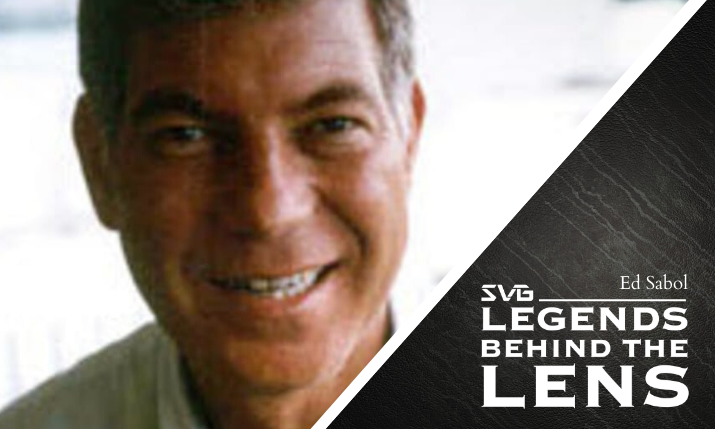Legends Behind the Lens: Ed Sabol
One of sports TV's original entrepreneurs set a standard for storytelling in sports still felt today
Story Highlights

The story of American sports television is engrained in the history of this nation, rising on the achievements of countless incredible men and women who never once appeared on our screens. During this pause in live sports, SVG is proud to present a celebration of this great industry. Legends Behind the Lens is a look at how we got here seen through the people who willed it to be. Each weekday, we will share with you the story of a person whose impact on the sports-television industry is indelible.
Legends Behind the Lens is presented in association with the Sports Broadcasting Hall of Fame and the SVG Sports Broadcasting Fund. In these trying times — with so many video-production professionals out of work — we hope that you will consider (if you are able) donating to the Sports Broadcasting Fund. Do so by visiting sportsbroadcastfund.org.
___________________________
By Carolyn Braff
Before Ed Sabol turned a bird’s-eye view of the NFL into an all-access backstage tour, his cinematic experience consisted of home movies. The immensely creative overcoat salesman envisioned a new way to tell stories and, as the founder of NFL Films, taught himself everything he needed to know to revolutionize the way Americans watch sports.
“He always said creativity is allowing yourself to make mistakes, or knowing which ones to keep,” said Steve Sabol, Ed’s son and former President of NFL Films, who died in 2012 at the age of 69.
Ed had a creative career long before NFL Films. A star swimmer, he set a world record in high school before winning Big Ten and National AAU championships in college. After trying his luck on Broadway, he sold overcoats at his father-inlaw’s store, but the Ed Sabol who changed the sports world was born when he received a 16mm Bell & Howell camera. Ed began filming his newborn son’s every move –including, later, his football games.
With the ever-present support of his wife, Audrey, Ed brought Steve onboard, and the two set to work making history.
“He always said, if you really believe in something, then you have to go after it, balls and all,” Steve said. “That was his very big expression: Don’t hold back, balls and all.”
Ed held nothing back with his first job, bidding $5,000 for the rights to film the 1962 NFL Championship game, doubling the previous year’s offer.
“Pete Rozelle was concerned when he saw, under experience on the application, my dad had written ‘filming my son’s high school football games,’” Steve said. “But after a three-martini lunch, my dad convinced Pete to give Blair Motion Pictures a chance.”
“My dad had the entrepreneurial vision to see that there was a business making movies about football. I don’t remember my dad ever having a head. It was always this man holding a camera on his shoulders.” — Steve Sabol
Ed’s experience as a rifleman during World War II inspired the title of the company’s first feature, Pro Football’s Longest Day. Rozelle introduced the film before New York City’s most influential sports writers at Toots Shor’s restaurant, but a waiter interrupted the premiere when he tripped over the projection cord. “We turned around, and there was our first film in a pile of crabmeat,” Steve said.
While Ed and Steve cleaned cocktail sauce off their life’s work, Rozelle and Frank Gifford held a makeshift press conference to keep the writers occupied. Despite the crabmeat intermission, the film received rave reviews, and the Sabols earned the rights to film the 1963 and 1964 Championships.
But Ed wanted more.
“My dad had the entrepreneurial vision to see that there was a business making movies about football,” Steve said. Ed convinced Rozelle that the league needed a motion-picture company dedicated to preserving the history of the game, and in 1964, NFL Films was born.
The company began with just four employees, two of whom were named Sabol and none of whom were technical wizards. But the creative license Ed assigned to his staff and the risks he took to gain support from league owners allowed NFL Films to deliver an exceptional product.
“He used to say, tell me a fact and I’ll learn; tell me the truth and I’ll believe; but tell me a story and it will live in my heart forever,” Steve recalled. “It wasn’t the outcome that was important; it was the struggle, the humanity of the game. It was our duty to tell that story as dramatically as we could.” Ed also told stories in primetime, persuading ABC to run the first-ever highlight segments, thereby creating an industry standard.
Dozens of Emmy Awards later, NFL Films has turned the tradition of football into mythology. Without Ed Sabol, who passed away in 2015, there would be no frozen tundra, no Immaculate Reception, and none of the stories that make the NFL so much more than a game.
